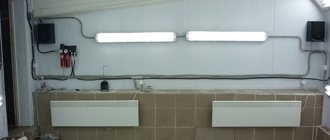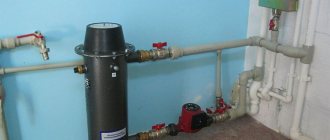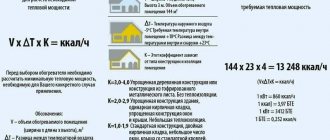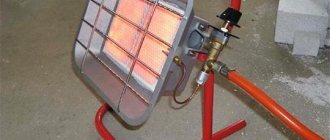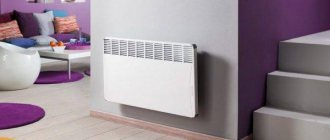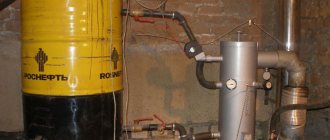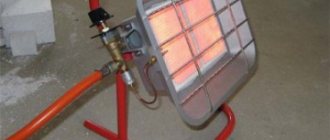Features of infrared heater:
- it warms the place where the radiation is directed, creating comfort comparable to cold nights by the fire, at low air temperatures;
- IR rays can be reflected from mirrored wall panels, so when lining the interior walls of a garage, savings can be made on the number of heaters;
- the costs of such heating are minimal, since the room is heated to the optimal temperature for work very quickly;
- safety and ease of maintenance (compared to other fast heating devices, for example, a potbelly stove).
The heat generated by an infrared heater is distributed better than with a conventional heating method.
The heater begins to function in operating mode 10-30 seconds after switching on, which is much faster than oil radiators. Such devices operate silently. And the operating efficiency breaks all records due to the direct heating of areas in the beam zone.
There are now hundreds of designs of infrared heaters on the market. They can have a different source of radiation: halogen, carbon, quartz lamps and other panels and strips. There are electric and gas infrared heating devices.
In garage conditions, models that are powered by electricity will be optimal. Despite the fact that gas heaters operating on a propane-butane mixture are equipped with a sensor for harmful substances and flame control, they still cannot be called absolutely safe.
Electric infrared heaters also have disadvantages. But they are minor:
- the high cost of some powerful models;
- compliance with installation requirements;
- the opportunity to purchase a low-quality product, a “pirated copy” of a famous brand.
Advantages and disadvantages
IR equipment has its advantages and disadvantages. Positive sides:
- local heating;
- easy connection and installation;
- fast warm-up even at low temperatures;
- variability of placement;
- built-in protection (models with thermostat)
The disadvantages are the price of new models and the high probability of overheating if installed incorrectly.
According to reviews from car owners, IR equipment is best suited for garages and workshops. Heaters are easy to select to suit your needs, and if you have the desire and knowledge, you can make them yourself.
Subscribe to TechnoCouncil on social networks so you don’t miss anything:
Infrared heaters for the garage: types and models
The ceiling in the garage is small, and only long-wave emitters can be used for this room. Models with short and medium waves can only be installed in large warehouses and production facilities (where the ceiling height is from 3 to 8 meters).
Almost all types of long-wave infrared electric heaters can be used in a garage. Popular ones are IR heaters on a stand. According to car enthusiasts, they not only heat the air well in the room, but also help get rid of mold and mildew in damp corners of the garage if the lamps are periodically directed at problem areas of the walls. Garage owners say that the emitter can be used as a dehumidifier for treated surfaces, which is important if there is construction going on in the garage or a workshop is operating. So, if you illuminate the putty with infrared rays, it dries in five minutes, the primer dries in eight minutes, and the varnish takes 12 minutes. The surface becomes smooth and even.
Another feature of the stand-mounted emitter is the ability to heat an outdoor work area with it. So if you change the wheels on your car for winter ones in front of the garage during frosts, such a device will help you not freeze outside.
Infrared emitters on the stand
Stand emitters are usually powered by a quartz or carbon lamp, which is protected by a durable glass tube. Such a lamp is safe; air is removed from the tube space, which eliminates the possibility of fire. According to information from manufacturers, such heaters have a life of 1.5 years of operation in maximum mode without interruption.
The difference for the consumer between a quartz and a carbon lamp is in particular the radiation of the latter, which corresponds to the natural level of human heat.
At the same time, a heater with a halogen lamp is not suitable for a garage, since it produces radiation with short waves, unsuitable for rooms with small ceilings.
The infrared film heater can be used in the garage. This type of heating is known as wall panels and infrared underfloor heating. Its advantage over counter-mounted devices is the ability to place the film on the floor, wall, or ceiling. You can connect a control system to the thermostat via a smartphone, and in winter, a warm floor will allow you to avoid wasting time heating the car. You will immediately enter a warm room.
Other features of the film and panel heater:
- does not take up space;
- more economical compared to stand-mounted emitters;
- can be installed in a pit, basement and other areas of the garage that are inconvenient for heating with lamps.
All infrared heaters, whether lamp, panel or film, are safe for the paintwork of the car, environmentally friendly and have a service life of 20 years. If so, then it makes no difference which brand of heater you buy? Not really. It is better to pay attention to European and Russian manufacturers, ignoring companies from the Middle Kingdom.
- Well-known in Russia, “Ballu”, “Master Hit” and “Ecoline”.
- Italian models, “ITM”, are distinguished by good moisture resistance of the case.
- Equipment from Germany from Eckerle, WAGO and Kroll is very economical.
- French heaters produced in Germany have the advantage of small size and high power.
The best fan heaters for a garage
This category of heaters is also distinguished by its immediate reach to operating temperature. The design is based on a heating element (spiral, corrugation, ceramic panel) and a fan. But the device is a little noisy and actively drives away dust.
RESANTA TVK-2
Rating: 4.9
In first place is a compact fan heater with vertical floor installation. There are two switches at the top - heating modes and fan speed. This allows you to configure the operation of the equipment in the desired way, depending on the temperature conditions in the garage. In the model, you can start ventilation with running heating, so the device will be useful in hot weather to supply air flow to a wet face. Heater power 1800 W, suitable for an area of 18 m². The built-in thermostat automatically turns off the heating element when the set temperature is reached. User reviews like that the heating element of the product is ceramic, so it lasts up to 10 years and does not burn out. This is also facilitated by built-in overheating protection.
Experts noted the product as the most budget-friendly for garage heating. Despite the low cost, the heater has a user-friendly interface, several operating modes and a nice design.
Advantages
- overheat protection;
- built-in thermostat;
- easy to carry;
- beautiful design with handle.
Flaws
- unstable base - easy to knock over;
- the cooler clicks when rotating;
- the mesh on the front panel cannot be protected if a flying bolt or wrench gets there.
Quattro Elementi QE-2000C
Rating: 4.8
A fan heater with a power of 2000 W is suitable for a garage with an area of up to 20 m². The heater has a ceramic heating element protected by a steel mesh. The cylindrical body can be pointed upward or sideways thanks to the adjustable angle on the base. The device weighs 1.7 kg and is designed for floor installation. It has a thermostat that independently controls the room temperature. The plastic handle does not heat up during operation and the fan heater can be rearranged at any time for local heating. User reviews like the device’s performance not only for heating the garage, but also for ventilation in the summer. The air flow comes out at a speed of 130 m³, which allows you to not sweat much when working with the car for a long time.
Our experts singled out the heater as the best in terms of durability. On the outside it is completely metal (except for the handle), which allows it to maintain its integrity if it is accidentally kicked. This is the most durable model for harsh operating conditions in the garage.
Advantages
- stable base;
- tilt angle adjustment;
- plastic handle for rearranging when in use;
- built-in thermostat.
Flaws
- dries the air;
- makes a lot of noise;
- there are no rubber pads on the legs to prevent slipping (for example, if placed on the hood of a car).
Calculation of power of IR heaters
Electric infrared heaters for the garage are selected based on their power. There are many models on the market for rooms of various sizes. The required power is calculated based on the volume of the garage required for heating. It is believed that one cubic meter of garage requires from 25 to 50 W. On average - 35 W per cubic meter.
When purchasing, it is important to already have an idea where the device will be installed. There is a minimum distance standard for a person working in a garage. Thus, the minimum distance to the head should be no more than 0.7 meters (with a heater power of about 750 W). If the device is more powerful, then the distance increases in direct proportion.
Online stores have offers for portable heaters with low power, such as 300 W. They are well suited for the garage, as they quickly heat the air to a comfortable temperature in a certain area and do not waste much electricity. You can work comfortably next to them even on the street.
The plates can heat up to a temperature of 600°. But the body is almost never above 60°. The weight of the devices does not exceed 5 kg, they can be carried with one hand.
The best heat guns for the garage
This category of equipment is represented by turbines that actively pump hot air through powerful fans. Suitable for heating large garages, but produce a lot of noise.
Sibrteh GH-10 (10 kW)
Rating: 4.9
In first place is a heat gun from the domestic brand “Sibirtech”. The GH-10 produces a thermal power of 10,000 W, which is enough to heat a garage with an area of up to 180 m². This is possible due to the combined operation system of the heater, in which heat is created by a gas burner, and its distribution is carried out by an electric fan. To use, you will need a network with a voltage of 220 V, as well as a liquefied gas cylinder connected through the fitting on the rear panel. You can direct the hot flow while the nozzle is burning by turning the body by the insulated handle. Buyers in reviews praise the product for the soft flexible hose that is included in the kit.
Our experts consider the product to be the best for heating large garages where trucks/commercial vehicles are repaired or stored. Using such a heat gun, you can heat a hangar with 10 Mercedes Sprinter minibuses. This will allow you to quickly heat the box in the morning, when the cars leave for the flight and the drivers need to check everything. When a couple of cars are being repaired, it will also be possible to create comfortable climatic conditions.
Advantages
- soft gas hose included;
- air exchange 300 m³/hour;
- comfortable piezo ignition;
- When overheated, it switches off.
Flaws
- short network cable;
- a gas appliance depends on electricity;
- simultaneous costs for gas and electricity (consumes 500 W/h).
Ballu BHDP-10 (10 kW)
Rating: 4.8
Here is another powerful heater in the form of a heat gun, well suited for spacious boxes and garages. The thermal performance of the heating element here is the same as the previous heater and is 10 kW. But the operating principle of the equipment is different. BHDP-10 runs on diesel fuel. For this purpose, there is a tank in the lower part, which plays the role of a base. From it, diesel fuel is supplied to the nozzle and burned in the chamber. The fan disperses heat throughout the room. The device is convenient because it does not require an additional hose or cylinder - everything is built into the body. But such a setup weighs 10 kg. There is a thick handle for moving it. User reviews like the thermostat with degrees marked, which makes it easy to set the desired temperature.
According to the magazine's editors, the heater is the best in terms of performance. With the same power of 10 kW as the previous model, it performs an air exchange of 590 m³, practically without equal. This allows it to be used in even larger garages (200-250 m²) or to warm up the space faster.
Advantages
- the warmth is felt just a couple of minutes after starting;
- temperature can be adjusted;
- relatively compact dimensions 28x40x68 cm;
- turns off when overheated.
Flaws
- weighs 10 kg;
- volatile device;
- not suitable for garages without ventilation (smoke);
- periodically requires replacing the air filter.
Ballu BKX-3 (2 kW)
Rating: 4.7
Heat gun with a power of 2000 W, which is suitable for rooms of 20-25 m². Her heating element consists of many corrugated metal strips sealed into ceramic, which increases the area of the heating element. At the rear, heat is dispersed by a powerful fan with a maximum air exchange of 120 m³/h. There is a power button with a rubberized pad that protects against moisture. The thermostat wheel allows you to set a temperature threshold, after reaching which the heater will turn off. The product dimensions are 17x17x19 cm and the device weighs 1.7 kg.
We considered the heater the best for its “indestructibility”. It is made entirely of metal and can withstand drops and accidental impacts that may occur when used in a garage. The controls are “recessed” under the casing, so they do not break off when hit by heavy objects. The front panel is covered with a dense thick steel grille, and will not allow bolts or flying nuts to damage the fan.
Advantages
- rubber start key;
- there is a thermostat;
- rigid steel frame and body;
- Heating element with a honeycomb structure.
Flaws
- if it’s -15 degrees outside, it can heat the garage to a maximum of 0…+2º C;
- noticeably dries out the air.
Wester TV-2/3ST (2 kW)
Rating: 4.6
Lightweight and compact heat gun with a power of 2000 W. Suitable for garages with an area of up to 15 m². Performs an air exchange of 140 m³/h. When overheating occurs, protection is triggered. With a weight of 3.4 kg and a thick insulated handle, the heater can be moved to the desired location to create additional local heating. The body provides mechanical control with two modes and a thermostat. In the reviews, the owners are satisfied with the long power cord, which allows the device to be used without an extension cord.
This heat gun is characterized by increased stability on slippery surfaces (tiles, metal). It also has a variable inclination of the hot air supply channel. We recommend that those who paint cars in the garage pay attention to the heater. With such a device, you can direct the flow onto the painted part and quickly dry the varnish so that dust does not stick to it. But due to the presence of a fan, the room must be kept clean, otherwise microparticles may appear on the painted surface.
Advantages
- there is a ventilation mode without heating;
- can be turned on at full or half power;
- mechanical switch with temperature indication up to +40 degrees;
- reliable powder coating of steel parts.
Flaws
- weak outer grill covering the heating element;
- The fan bearing may need to be repaired (replaced) periodically.
RESANTA TEPK-2000K (2 kW)
Rating: 4.5
Heater in a short cylindrical shape with a ceramic heating element. A heat gun consumes 2 kW per hour and heats up to 20 m². The cooler performs air exchange in a volume of 120 m³ in 60 minutes. The device is located on a curved stand equipped with rubber pads. Controls in the form of a thermostat and mode switch are located under the handle. In the reviews, owners are satisfied with the heater’s compactness and lightness (1.5 kg). Buyers are advised to run the fan for another 20-30 seconds after turning off the heating element to quickly cool the heating panel. This allows you to reduce the temperature to a safe value and leave the garage where gasoline and oil are stored with a “peaceful heart.”
This heater is the best in terms of price and quality ratio. Its heating element is made of ceramics and has virtually no service life limitation. By purchasing such a device for your garage, you will spend one time and get a heater for life at an affordable price.
Advantages
- several heating modes;
- separate fan operation;
- temperature control by thermostat;
- light indication of switching on.
Flaws
- at -15 degrees outside, in the garage it is not effective;
- makes a lot of noise;
- sometimes the blades can touch the casing;
- short network cable.
DIY IR heater
If you want to do something yourself, you can make your own IR heater. There are many ways described on the Internet, from the real to the most incredible. We studied them and selected the two most realistic options for creating an infrared heater for the garage.
The easiest way is to make a heating device from an old reflector with a spiral, which can be purchased at a flea market, according to advertisements on the Internet. In addition to the Soviet-style reflector, you will need:
- steel rod;
- fireproof dielectric (a plate made of glazed ceramics is suitable);
- nichrome thread.
Having all these parts, making a heater is quite simple.
- First, check the integrity of the electrical cable, the plug of the Soviet reflector. If there is dust on the reflector of such a device, it must be removed.
- Take out the spiral and measure its length. Take a steel rod of the same size as the spiral and wind a nichrome thread onto the rod in 2 mm increments. Remove the resulting spiral.
- Take a fireproof dielectric (plate) and place your spiral on it. Connect it to the current so that the turns do not touch. Wait until it warms up. Disconnect from current.
- Take the spiral and place it in the groove of the reflector cone, connecting it to the power supply.
The second option is to make a heater from glass and foil. This option is more suitable for those who are fans of the “Crazy Hands” program, since the heater is made from a bunch of unnecessary things.
Stages of work:
- We smoke glass. To do this, a lit candle must be placed on the table, and the plates must be moved alternately over its flame. It is necessary to have a layer of soot on only one side of each piece of glass.
- We clean the edges of the glass from soot with cotton swabs so that we get a transparent frame 5 mm wide.
- Take a piece of aluminum foil and cut out a couple of rectangles the width of a soot rectangle and a little longer than a piece of glass. In our case, the soot will be a conductor, and the pieces of foil will be electrodes.
- Let's assemble our device. To do this, turn the glass plate with the soot side, apply epoxy glue to it, and place two pieces of foil so that both ends extend beyond the glass. We attach the second plate on top so that the layer of soot is inside. Let the glue work.
- We treat our device with sealant.
- We take a multimeter and replace the resistance or power of the heater. If you can only determine the resistance, then to calculate the power you need to multiply the resistance by the squared current.
- Typically, the power does not exceed the value allowed by regulations. But if it doesn’t work out, and it’s higher, you’ll have to rebuild the heater again. Remember that the wider the soot strip, the less resistance.
Assembling heaters from scrap parts is good fun for Sunday garage get-togethers. But if you plan to use the device often, care about safety and are not very limited on funds, then buy a factory-made heater. After all, such infrared devices are more reliable than even a reflex radiator with an open spiral. Its use is dangerous in a garage, since the combination of a hot element and gasoline and oil vapors can create the risk of a fire.
In modern models, all hot parts (if any) are hidden firmly in glass, so you can use them in the garage with the car engine running and not fear for your life.
The use of infrared heaters in various rooms (including the garage) is described in this video.
